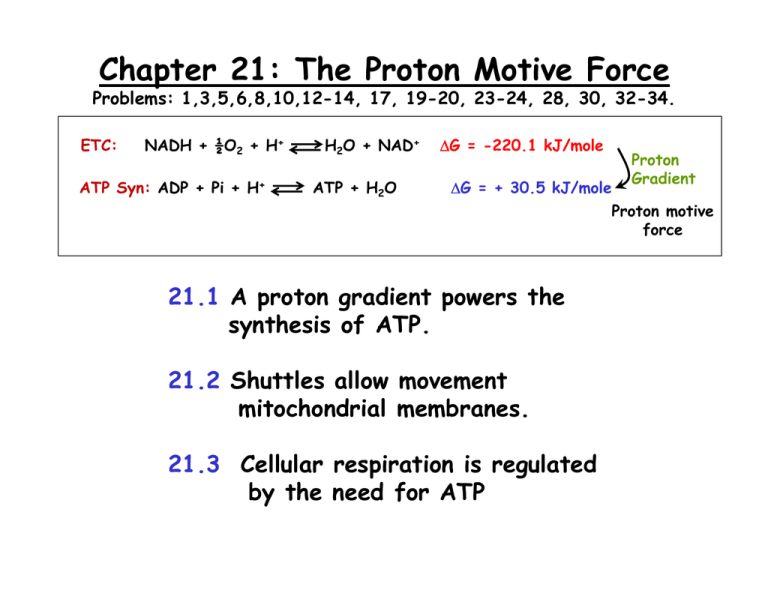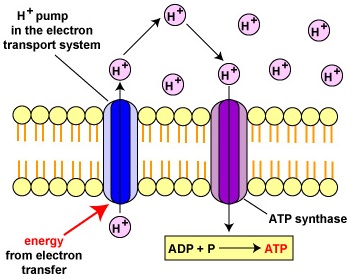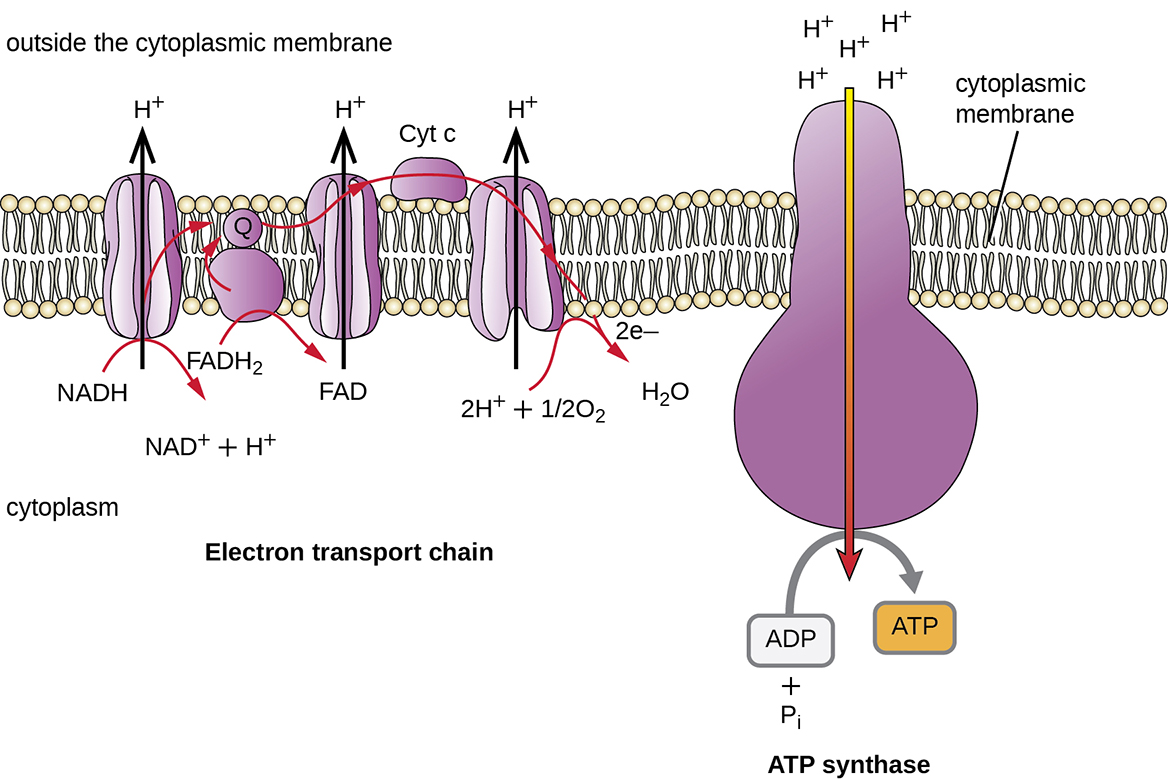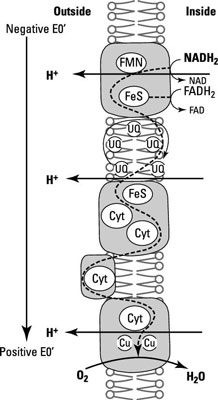The proton motive force occurs when the cell membrane becomes energized due to electron transport reactions by the electron carriers embedded in it. The net effect of these two transport processes is that the proton gradient drives the concentration of ADP and phosphate inside the mitochondrion and the export of ATP at the expense of 1HATP synthesized.

Chapter 20 21 Electron The Proton Motive Force And Atp Synthesis Flashcards Quizlet
Shiozuka Tani Mizushima Tokuda 1990.

. Proton motive force PMF a source of energy resulting from the separation of protons from hydroxyl ions across the cytoplasmic membrane generating a membrane potential. Schiebel Driessen Hartl. The proton-motive force created by the pumping out of protons by the respiratory chain complexes is in the mitochondria of most tissues mainly used to translocate protons through the ATP synthase complex leading to the formation of ATP from adenosine diphosphate ADP and phosphate.
Experiments with the aerotolerant anaerobe Streptococcus lactis provide the opportunity for determining the proton motive force Deltap in dividing cells. The thylakoid proton motive force pmf the transmembrane electrochemical gradient of protons generated during the light reactions of photosynthesis is a fundamental entity of bioenergetics coupling light-driven electron transfer reactions to the phosphorylation of ADP via the ATP synthase Avenson et al 2004. Descriptors are arranged in a hierarchical structure which enables searching at various levels of specificity.
In K-depleted cells of the glycolytic bacterium STreptococcus faecalis the addition of K ions caused a depolarization of the membrane by about 60 mV. - one function of the respiratory chain is to regenerate NAD for glycolysis. Most important thing here is that the energy expressed here as Gibbs free energy electrochemical proton gradient or proton-motive force PMF is combination of two gradients across the membrane.
Proton-Motive Force is a descriptor in the National Library of Medicines controlled vocabulary thesaurus MeSH Medical Subject Headings. Bacterial membranes can generate the proton-motive force PMF through the electron transport chain and it is known that SecYEG transduces the energy available in the PMF to stimulate protein translocation Brundage et al 1990. Proton-coupled accumulation of galactoside in Streptococcus lactis 7962.
Accumulation of neutral amino acids by Streptococcus faecalis. Proton motive force PMF is the force that promotes movement of protons across membranes downhill the electrochemical potential. The proton-motive force created by the pumping out of protons by the respiratory chain complexes is in the mitochondria of most tissues mainly used to translocate protons through the ATP synthase complex leading to the formation of.
Biocompatible click chemistry enabled compartment-specific pH measurement inside E. The two components of Deltap DeltaPsi the transmembrane potential and DeltapH the chemical gradient of H were determined by the accumulation of radiolabeled tetraphenylphosphonium. Mitchell defined the proton-motive force PMF as.
Proton motive force PMF is the force that promotes movement of protons across membranes downhill the electrochemical potential. At 25C 298K this equation takes the form. The novelty of such an energy coupling mechanism and its relevance to oth.
Overview A difference of solute concentration between two compartments separated by a biological membrane generates a tendency to equilibrium which in the case of protons is called proton motive force PMF. Electrons from cytoplasmic NADH enter mitochondria by shuttles. Asghar SS Levin E Harold FM.
However since the depolarization was compensated for by an. Energy coupling by a proton-motive force. Energy that is generated by the transfer of protons or electrons across.
Google Scholar Kashket ER Wilson TH. Basically this causes the cell to act like a tiny battery. Δμ H 1 kJmol coresponds to Δp 104 mV.
Its energy can either be used right away to do work like power flagella or be stored for later in ATP. Cells of Escherichia coli pump cobalamin vitamin B12 across their outer membranes into the periplasmic space and it was concluded previously that this process is potentiated by the proton motive force of the inner membrane. Recent papers in Proton Motive Force.
Geller Movva. The influence of K ions on the components of the transmembrane proton motive force delta mu H in intact bacteria was investigated. Skip to main content.

Electron Transport Chain Bioninja

110 Proton Motive Force Youtube

Proton Motive Force An Overview Sciencedirect Topics

110 Proton Motive Force Youtube
Solved During Oxidative Phosphorylation The Proton Motive Force Electrochemical Gradient That Is Generated By Electron Transport Is Used To Course Hero

Cellular Respiration Microbiology

Passive H Flux Across The Plasma Membrane Is Governed By The Proton Download Scientific Diagram

Chapter 21 The Proton Motive Force

Proton Motive Force Is Required To Drive Mitoflash Generation Download Scientific Diagram

18 3d Electron Transport Chain And Chemisomosis Biology Libretexts

Figure 1 From Probing The Dynamics Of The Proton Motive Force In E Coli Semantic Scholar

The Proton Motive Force Chapter 21 Stryer Short Course Ppt Download

8 3 Cellular Respiration Microbiology Canadian Edition

Light Harvesting And Generation Of The Proton Motive Force In Prp Download Scientific Diagram

The Proton Motive Force Dummies

Proton Motive Force Is Required To Drive Mitoflash Generation Download Scientific Diagram

Proton Motive Force An Overview Sciencedirect Topics

Chapter 14 Part 2 Oxidative Phosphorylation Proton Motive Force P Pmf Is The Energy Of The Proton Concentration Gradient The Chemical Ph Ppt Download
